Composer Leonid Hoffman. The Principal Theme in the 1st Movement of the Fifth Piano Sonata by Beethoven
I recall this incident not to settle an old score with a friend, but to try, just in one go, to formulate a problem whose practical significance will grow as modern music advances from its present state to the day when the historical continuity is restored and the classical values re-assert themselves in the public mind. The way lies trough the awareness of Schoenberg's achievements as a composer, theoretician and a teacher. Although today, one can hardly deny his heritage, this does not mean this heritage has been mastered.
The most obvious of Schoenberg's merits are as a teacher. To single out his genius as a composer from the 20-century monotonous discordance is a much more serious undertaking. As for Schoenberg as a theoretician, one will not even start to appreciate what he has done in this area (which is inseparable from the other two) without immediate contact with either the man himself or his few pupils. On the other hand, Schoenberg rejected the honor of this title out of hand.
At this point, quote from Philip Herschkovitz would be apt, "Dissociating himself from the theoreticians by saying he is not setting forth a theory, but a systematic description of music, the great Schoenberg did not realize (without any prejudice to his greatness) that this reservation made him akin to Jourdain who did not know he spoke prose, purely theoretical in Scheonberg's case. It would be gust right to believe that the grand masters like Bach, Beethoven or Wagner were just as great theoreticians as they were as composers."
Schoenberg was undoubtedly all of a piece, equally a prodigy in his three hypostases every one of which mutually determines to the other two. When Herschkovitz, with his mastery of brilliant paradox, repudiates Schoenberg, enhancing the meaning of the term "theoretician", while Schoenberg himself fully realizes the advantages of the status of practical composer, which allows him to avoid competition with theoretician in an area in which (as he assumes) the law called inspiration predominates. The tragic paradox of our time is, that Scheonberg's theory, which is practical in the highest degree, contradicts the present-day practice of instruction. Today, a teacher can, at best, help his student in solving a problem, while the actual purpose should be to lead a young musician to formulating a problem on his own.
* * *
Whereas in the field of harmony Schoenberg demonstrates the entire wealth of tonality with an exhaustive completeness, in the field of form he acts differently: he reduces all diversity of form to a few concepts like three types of theme form, four kinds of movement, and some others. Moreover, in the master works we could see the pure type of form (Schoenberg's school form) only as an exception. In contrast to the theoretician whose possibilities are limited by his attempts at classification, Schoenberg (like ancient geometrician who discovers the abstract notions of point, line and plane which don't exist in the physical world) creates the abstract notion of school form, "which differs, often considerably, from reality". (See Schoenberg's Structural Functions of Harmony.)
Failures by theoreticians both in the field of analysis and also in their attempts at constructing the theory of form are explained by their very theoretical approach, as they try to classify things, which can hardly be called elementary. Dmitri Mendeleyev succeeded in his classification of elements exactly because he compared weights of substances at their atomic level, an elementary level in chemistry. What would his results have been had he proceeded from, say, the molecules?..
This is why in Schoenberg's system the school form play a part far beyond the purely pedagogical purpose. He needs them - we cannot but agree with Herschkowitz - as a theoretician. It is not that any definition we may take up of elements of musical form (unless we restrict its use to school form only) shall immediately bar the road into the future to a composer, deny him any prospects or, much more likely, will be disproved by his own practice. Understanding the "physical world" reality, this organic ("bio-chemical") nature of the great master's works, is beyond those who have not grasped the "non-organic chemistry" of Schoenberg's school forms.
The art of analysis which the New Vienna School has evolved to a highest degree is based on its exponent's keen awareness of the problem of form set by composer. It is the distinction between Beethoven's period, sentence, and ternary song, for instance, and there school form prototype that constitutes "a problem of creation (whether the author is aware of this or not) whose resolution gives rise to a movement originating from the theme." (Ph. Herschkovitz. O muzyke. Moscow, 1991.)
* * *
It is completely clear that when we define our theme as a sentence (m 1-16) with closing measures (17-22) and a repeated development (m23-30) we first and foremost mark that the belongs among a number similar ones, or pertains to its "etymology", to borrow a word from linguistics. Let us trace this on several examples. The first sixteen measure of the second Bagatelle, Op.33 present a rarest case of the school form sentence by Beethoven. (4+4 is a motif and its repetition, 2+2, 1+1+1 measure is the development bringing to the liquidation in the 16th measure.)

The function of the motif is clearly seen from the following scheme. If ABCD is a motif, the sentence will be ABCD+ABCD+AB+AB+A+A+A+ one measure of liquidation.
The characteristic peculiar to the sentence is its capacity to join a repeated development. (Op.2/3-1; the principal theme consists of m. 2+2 - the motif and its repetition, m. 5-8 -development, m. 9-13 is a repeated development. We find a similar example in Op. 23-1 (Violin Sonata)
The principle theme in Op. 13-3 consists of a sentence (m.1-8), repeated development (m.9-12) and the closing measures (m.12-17).
Hence this chain of examples leads us to the place in their hierarchy taken by the principal theme of Op. 10/1-1 when Beethoven, as if wishing to complicate an experiment, introduces the closing measures immediately after the sentence and closes the theme with a repeated development. Noting the originality of the given theme, I have to point out an obvious peculiarity: the repeated development is fulfilled by that half of the motif which was absent earlier in the development of mm. 9-16, as it was omitted in the process of the motif being cut in half. In order to find out the reasons for the appearance of such a situation we must analyze at depth the structure of the motif and reveal its principal distinction relative both to the school form (See the Bagatelle Op, 33-2) and to etymologically familiar constructions. Whereas, the motif in the several examples listed for comparison has invariably clear and simple limits marked by a rest or a certain caesura, the motif in the theme we have analyzing does not posses such a characteristic. It is not separated from its repetition by a rest. On the contrary, the two "stick together" producing a shared chord.
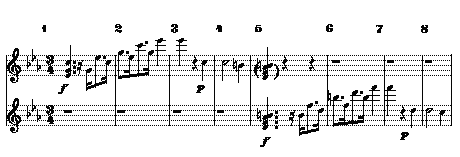
Even though a glance at the introduction to the development (mm.106-117) will leave us with no doubt that this treatment of the motif cannot possibly be considered as my own invention, we can nevertheless see that in cutting up the motif, Beethoven proceeds from a basically different interpretation. Indeed, the two-measure unit (mm.9-10), which has arisen from this split in terms of motif and appears as compression thematically, does not contain the last strong beat I have regarded as the one shared between the motif and its repetition. Puzzling?
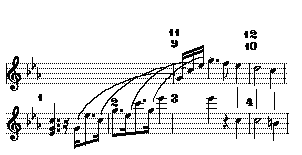
I will insist, however, that this beat is still there, albeit in a latent form. To be more precise, what we find here is the principle of overlapping, generated by the shared beat, this principle continues to operate at both the motivic and the thematic levels.
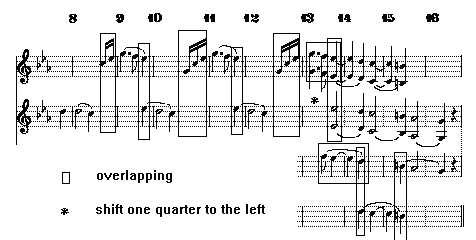
As a result, the last three one-measure units of the four shift one quarter to the left. To sum up, we deal with a fundamental structural contradiction. On the one hand, we find a development based on motif treatment wherein overlapping is denied. On the other hand, this development draws actively on overlapping, which is essential to the theme.
In other words, the development exploiting the principle of overlapping is accomplished by means of a motif which makes no provision for such a possibility. It would seem logical that repeated development is to resolve this contradiction. This conclusion, as we shall see, is premature. In contrast to the development in mm. 9-16, none of the structural elements in the repeated development depend on the principle of overlapping to provide links with any other element. Beethoven's impeccable sense of form, which equals only his heroic sense of duty, fills us with admiration when we discover that in the absence of overlapping the last three of the four one-measure units shift one quarter again, this time to the right!
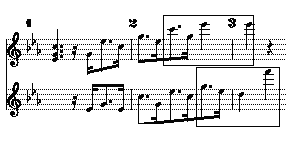
Let us now get down to reconstructing the motif underlying the repeated development. Let us ask ourselves: half of which four-measure unit are the two-measure units in mm.23-24 and 25-26?
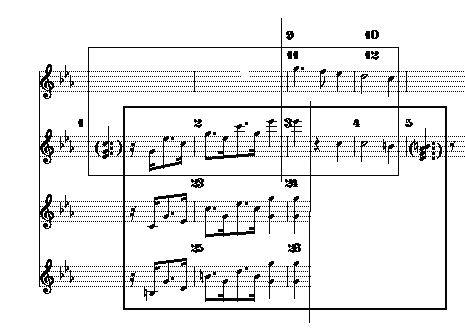
In this example, we see that the two-measure unit (mm.23-24) has resulted from the motif being cut by a line which does not coincide with the one cutting the motif to form the two-measure unit in mm. 9-10. This means that Beethoven does not merely use part of the motif he earlier avoided, as I said before. In doing this, he defines a motif's borders in a different way, removing the first, (and not the last!) beat outside the limits, re-numbering the measures anew. Consequently, Beethoven does not resolve what I describe as the fundamental structural contradiction in the repeated development, but merely paraphrases it, turning it 'inside out'. In the repeated development he comes to complete clarity and simplicity which avoids overlapping, but achieving this by means of a motif, whose limits include the first beat in the fifth measure, thanks to which the overlapping appeared as a structural principle in the theme.
Thus, in fifth piano-sonata we have an instance, which occurs in his other works, of a dually treated motif. Using one version as basic, Beethoven proceeds with the development; he then takes up another one for its repetition, yet the opposed version is always invisibly present in both the first and the second cases. If I were to speak in parables, it is as if two piano professors phrasing one of his pieces and insisting on different interpretations were to seek his supreme judgment as the author, "Which of us is right?" would be told, "You both are". Both are wrong, because each denies the existence of the other's version. Yet, both are right, since, accosted with a question "this or that" Beethoven answers " this and that". In Beethoven's sonata, the two versions actually coexist!
* * *
Conceivably, the above structural contradiction could be described as dialectic. Certainly not in terms of vulgar musicology, but because the Nature, whose ideal listener and instrument Beethoven was, contains contradictions in itself. Referring to our sonata it would be simpler still to use Lenin's famous phrase, "superhuman music", meaning, however, that, unlike Beethoven, humanity is inclined to simplification. Yet, Art, Nature or social life (as another politician said in different circumstances and on a different occasion) "there is no such thing as a simple solution".
P. S. I think, the question my friend asked at the beginning of this article requires no answer. The reader has certainly found the answer on his own. However, I have reserved more words for those who have not done so. The first beat in the first and in the 22nd measure are the same chord. Viewed as form, they are absolutely different. In the first measure, the motif begins with this chord. In the 22nd, it provides the end for the closing measures, and nothing else. The next two-measure unit will begin with the upbeat to the 23d measure. Otherwise Beethoven would have really used ff in the 22nd measure, or would not have put in anything at all! But Beethoven does write f, helping, certainly those who could do it, to understand that there is no place for overlapping, and that a return to the previous situation is impossible. If you prefer, Beethoven expresses his pathos through structure. Philip Hershkovitz put it in a nutshell, "the content of music", he said, "is its form".
Leonid Hoffman
/translated by Slava Semenov and Leonid Hoffman./